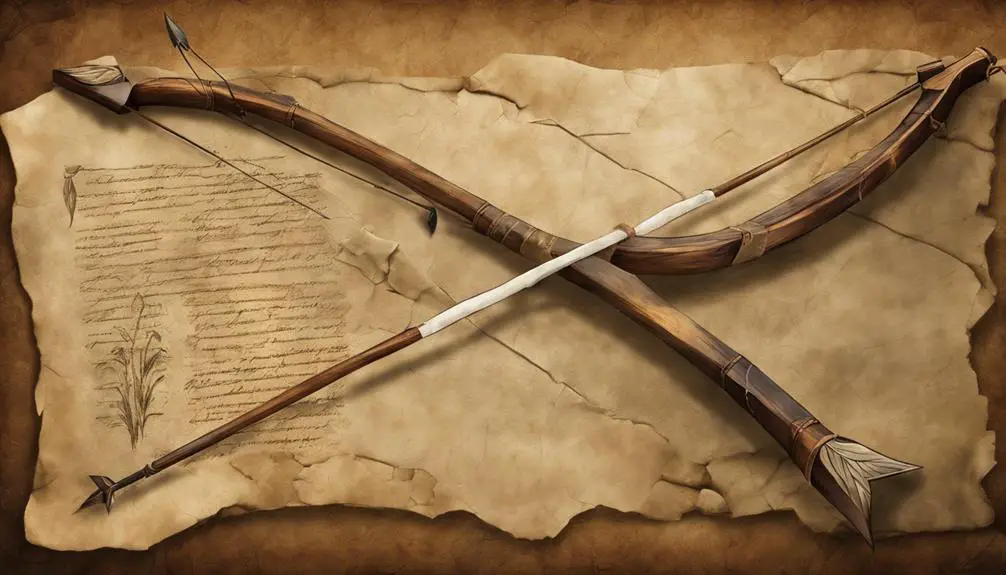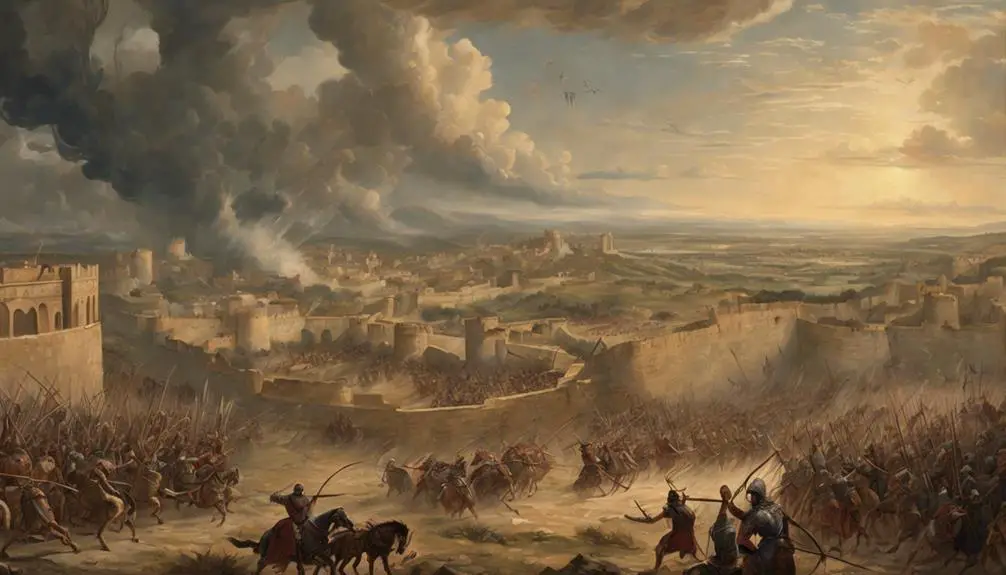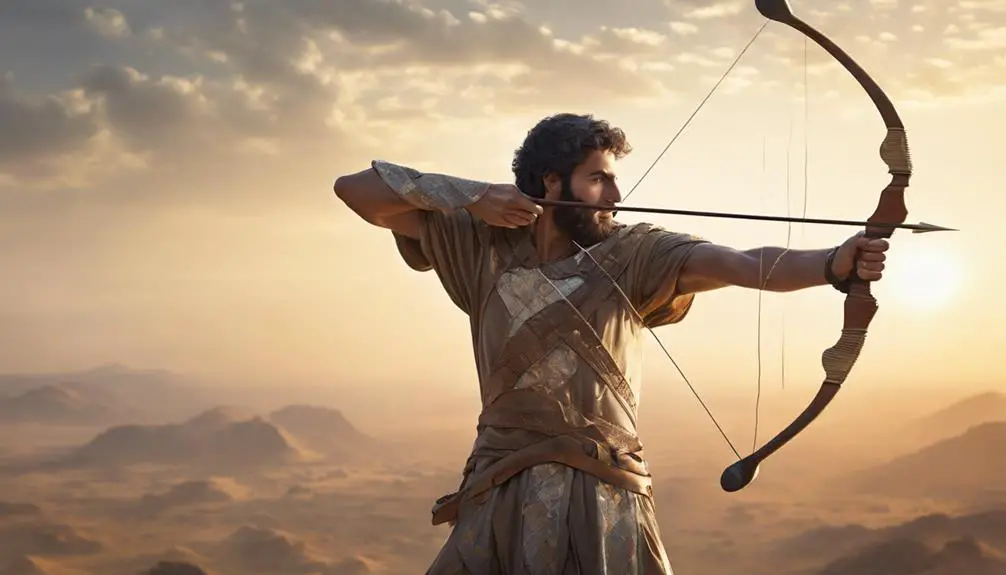Journey through biblical narratives to uncover the symbolic power of archery, revealing divine mysteries and human courage.

Archery in the Bible
In the tapestry of biblical narratives, the bow and arrow serve not merely as weapons of war but as potent symbols of divine intervention and human struggle.
You'll find that archery weaves its way through tales of conflict, serves as metaphors for God's wrath and protection, and highlights characters whose skills with the bow mark them as figures of significance.
As you explore the roles and representations of archers in the Bible, consider what these stories convey about power, precision, and faith.
The journey through these ancient texts may just offer unexpected insights into the complexities of human nature and divine guidance, inviting you to ponder deeper layers of meaning that have resonated through the ages.
Key Takeaways
- Archery symbolizes divine power and judgment, reflecting God's protective and punitive actions in biblical narratives.
- Prophetic imagery often utilizes archery to emphasize spiritual accuracy and divine intervention in human affairs.
- Renowned biblical archers exemplify the integration of physical skill and spiritual guidance, highlighting the importance of preparation and focus.
- Archery serves as a metaphor for spiritual discipline, urging the faithful towards consistent practice and dedication in their spiritual lives.
Archery in Warfare

In biblical times, the bow and arrow served as crucial instruments in warfare, shaping the strategic dynamics of ancient battles. The meticulous art of bow construction and the advanced arrow technology of the era significantly influenced military tactics and outcomes. You'd find that the design of the bow, often crafted from flexible yet sturdy wood, integrated materials like horn, sinew, or metal to enhance its tension and resilience. This careful construction allowed for a more powerful and longer-range weapon, essential in warfare where distance could mean the difference between victory and defeat.
Arrow technology, equally sophisticated, involved the precise shaping of arrowheads from materials such as iron or bronze. These were then affixed to wooden shafts with feathers attached to the other end, improving aerodynamics and accuracy. The combination of these technologies enabled archers to strike with lethal precision, even under the most challenging conditions.
Analyzing these elements, it's clear that advancements in bow construction and arrow technology weren't merely about improving the efficiency of these weapons. They were about mastering an art form that could tilt the balance of power, demonstrating the deep tactical thinking that ancient warfare demanded.
Symbols of Divine Power
Beyond their practical uses in warfare, bows and arrows also emerged as potent symbols of divine power within biblical narratives, reflecting a deeper spiritual dimension intertwined with the physical realm. This symbolism conveys the omnipotence and protection offered by the divine, using archery as a vivid illustration. In the context of the Bible, these items aren't merely weapons but become spiritual metaphors, encapsulating the interaction between the divine and the human.
- Divine imagery: Bows and arrows serve as visual representations of God's intervention, illustrating His ability to strike at a distance, pinpointing the precise moment of action.
- Spiritual metaphors: They symbolize the projection of divine will, where arrows represent directed divine intentions, and the bow, the omnipotent force behind them.
- Protection and judgment: Through these metaphors, the Bible conveys themes of protection for the faithful and judgment against adversaries, underlining the dual nature of divine power.
In examining these symbols, you're invited to delve into the layers of meaning behind the biblical text, where physical elements like bows and arrows transcend their materiality to express complex spiritual truths. This analytical perspective uncovers the rich tapestry of divine imagery and spiritual metaphors that archery embodies within the sacred scripture.
Prophetic Imagery and Archery

Archery serves as a canvas for prophetic imagery in the Bible, painting a vivid picture of future events and divine intentions through the metaphor of bows and arrows. The symbolic use of archery metaphors not only enriches the narrative but also emphasizes themes of spiritual accuracy and divine intervention. This portrayal invites you to delve deeper into the layers of meaning behind each prophetic message, encouraging a closer examination of your own spiritual aim and readiness.
Verse |
Interpretation |
|---|---|
Jeremiah 50:9 |
God's precision in targeting Babylon's downfall is likened to skilled archers. This demonstrates the inevitability and accuracy of divine judgment. |
Psalm 11:2 |
The wicked are compared to archers lurking in shadows, aiming at the upright. It symbolizes the constant threat to righteousness and the need for divine protection. |
Habakkuk 3:9 |
The Lord's bow is mentioned as being made ready for judgment, symbolizing the preparation and certainty of God's actions in history. |
Each example illustrates how the Bible uses archery metaphors to convey complex ideas about divine will, justice, and human morality. You're invited to ponder the precision of God's actions and the spiritual accuracy required of believers, drawing closer to the profound messages woven through Scripture.
Archers of Renown
Throughout biblical history, certain archers have distinguished themselves, not only for their prowess with the bow but also for the significant roles they played in unfolding divine narratives. These individuals, often emerging from notable archers' lineage, underscore the importance of heritage and divine purpose in their mastery of archery. Their stories, deeply embedded in the fabric of biblical tales, offer a unique lens through which to view the integration of skill, faith, and destiny.
The training methods of these archers were rigorous and deeply spiritual, suggesting a blend of physical discipline and divine guidance. The emphasis wasn't solely on physical strength or technique but also on mental and spiritual preparation. This holistic approach to archery training is evident in:
- The meticulous selection of wood for bows, symbolizing a deep connection with nature.
- The crafting of arrows, which often involved prayers for guidance and accuracy.
- The mentorship received from experienced archers, highlighting the importance of tradition and continuity.
Such practices underline the complexity of archery in biblical times, where it was more than a martial skill; it was a discipline that intertwined with faith, heritage, and the fulfillment of divine missions.
Lessons From Biblical Archery

Examining biblical archery reveals deep, multifaceted lessons that can guide individuals in their personal and spiritual development. You'll find that archery metaphors in scripture aren't merely historical references; they serve as profound symbols for spiritual discipline and moral guidance.
For instance, consider the precision and focus required in archery – these qualities aren't just vital for hitting a physical target but are equally essential in your spiritual journey. This analogy encourages you to aim your life with intention and purpose, highlighting the importance of setting spiritual goals and striving with determination to achieve them.
Moreover, the process of drawing a bow and aiming signifies the preparation and strength that spiritual discipline demands. Just as an archer must practice regularly to improve their skill, you too must engage in consistent spiritual exercises, such as prayer and meditation, to strengthen your faith and moral resolve. This comparison between archery and spiritual discipline underscores the necessity of patience, perseverance, and dedication in your personal development and faith journey.
Through these archery metaphors, scripture imparts critical lessons on the value of focus, preparation, and continuous effort in cultivating a strong, disciplined spiritual life. Reflecting on these lessons can inspire you to aim higher in your personal and spiritual aspirations, guiding your path with precision and unwavering commitment.
Frequently Asked Questions
How Did the Design and Materials of Bows and Arrows in Biblical Times Differ From Those Used in Modern Archery?
You're exploring how the design and materials of ancient bows and arrows differ from modern ones.
Historically, arrow types and manufacturing techniques were limited by available resources. Ancient arrows were often made from wood, with stone or metal tips, contrasting with today's carbon and aluminum options.
Additionally, the manufacturing process relied heavily on handcrafting, as opposed to the precision engineering and materials science that define contemporary archery equipment.
This shift reflects significant technological and material advancements.
Were There Any Specific Rituals or Blessings Associated With Archery Before Going Into Battle as Mentioned in the Bible?
You're diving into the intriguing intersection of spirituality and warfare.
Interestingly, the Bible doesn't specifically mention archery prayers or rituals for battle preparations, contrasting sharply with the detailed accounts of warfare tactics. This silence is telling, suggesting that archery, while a critical skill, was viewed more as a practical tool than a sacred act requiring divine intervention.
Analyzing this, it's clear that the emphasis was on faith and divine will, rather than on rituals for martial success.
Beyond Warfare and Symbolic Imagery, Does the Bible Reference Recreational or Competitive Aspects of Archery?
You're delving into whether recreational or competitive aspects, like hunting practices and archery contests, are mentioned beyond their martial symbolism.
While the Bible richly references archery in warfare and metaphor, it's scant on detailing archery for sport or competition.
This absence suggests that, historically, the focus was more on archery's practical or symbolic roles rather than its potential as a leisure activity or a platform for competition among individuals.
How Did the Skill and Training of Archers in Biblical Times Compare to the Standards of Modern Archers?
You're embarking on a quest to compare ancient archers, who could hit a fly from a hundred paces, with today's sharpshooters.
Diving into this analysis, we find that archery metaphors and historical accuracy paint a rich tapestry. Ancient training lacked our scientific rigor but was steeped in necessity and survival.
Modern archers benefit from technological advancements and precise methodologies, setting a stark contrast in standards and practices across the ages.
Are There Any Dietary or Lifestyle Practices Mentioned in the Bible That Were Believed to Enhance an Archer's Prowess or Accuracy?
You won't find specific dietary or lifestyle practices aimed at improving an archer's prowess in historical texts.
However, archery metaphors and spiritual symbolism are prevalent, suggesting an indirect link between a virtuous life and skill in archery.
Scholars analyze these metaphors, inferring that discipline, focus, and a righteous path could enhance an archer's accuracy.
This analytical perspective connects physical abilities with spiritual and moral discipline, albeit not explicitly stated.
Conclusion
In the tapestry of biblical narratives, archery weaves a thread of divine power, prophetic imagery, and the valor of renowned archers.
You've seen how the bow, in its silent whisper of a string's release, symbolizes more than mere warfare—it embodies messages from the divine, foretelling destinies interwoven with the human condition.
Through the lens of archery, you've glimpsed a profound layer of spiritual warfare and moral lessons, illustrating that every arrow shot in the biblical text targets the heart of human experience.



Sign up